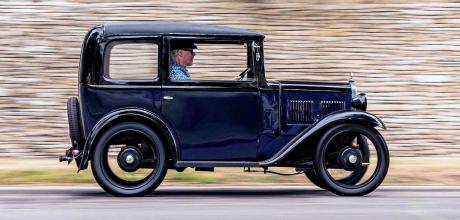1932 Austin Seven
This year marks 100 years of the Austin Seven. Mark Dixon drives a rather special example to a very special event.
Photography Barry Hayden
AUSTIN SEVEN CENTENARY
Paying homage, with the late Tony Dron’s car
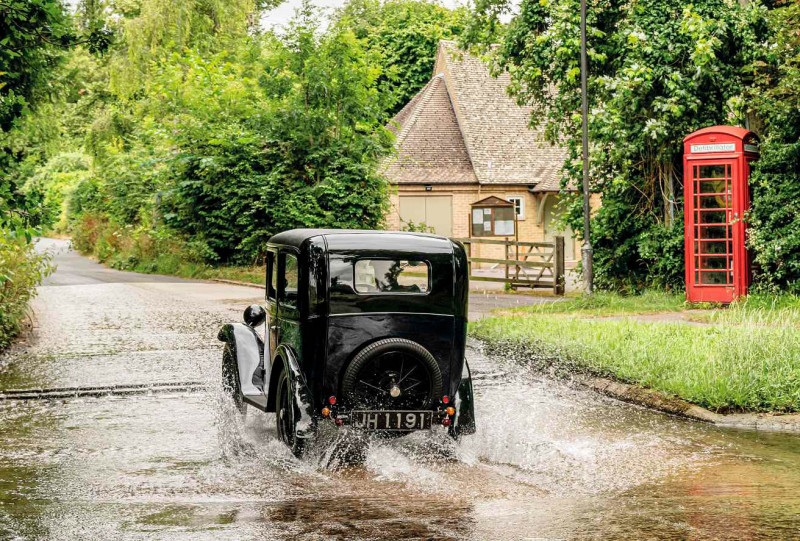
The ability to find pleasure in driving any car, no matter how humble, is surely what defines a real petrolhead, and no-one epitomised that more than the late and much-missed Tony Dron. A contributor to Octane for many years, he described back in early 2011 what it’s like to race a unique Drogo-bodied Ferrari 250GT SWB Competizione at the Goodwood Revival; a few pages further on, he was writing enthusiastically about his latest car purchase, a barn-find Austin Seven saloon.
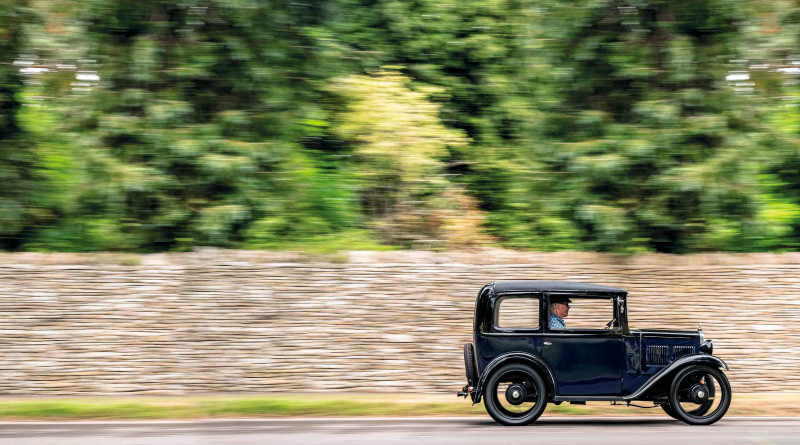
Tony bought his first Seven at the age of 11, which he planned (but failed) to turn into one of the Specials that were hugely popular in the 1950s. His first actual road car was a 1932 Seven Box Saloon, purchased for £30 in 1964. His final classic was also a 1932 Box Saloon, one of the last built on the 6ft 3in ‘short’ wheelbase, and it’s the car pictured here. ‘Despite being 6ft 5in tall, I was always very comfortable in Sevens,’ he said when he introduced it in Octane 93. But then Tony always did like small cars. Among his recent daily drivers were a Citroën 2CV, a Daihatsu Sirion and a Ford Fiesta; further evidence of his total lack of car-snobbery.
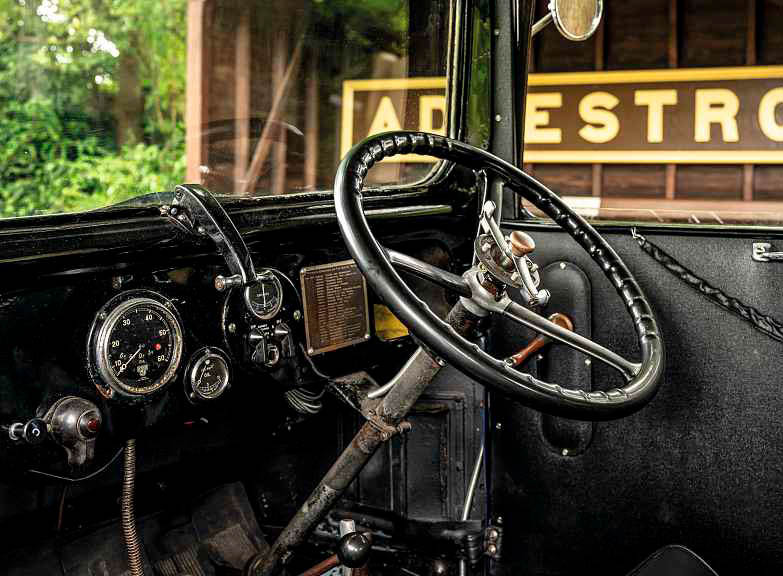
Tony passed away on 16 November 2021, after a long struggle with lung disease. But in July that year he managed to drive his Seven single-handedly from his Cambridgeshire home to a Seven Club rally at Beaulieu, a round trip of 330 miles spread over three days. If he’d survived a bit longer he would certainly have tried his damnedest to bring it to the Seven centenary celebrations this July, when nearly 1000 cars and their owners congregated in the beautiful English Cotswolds.
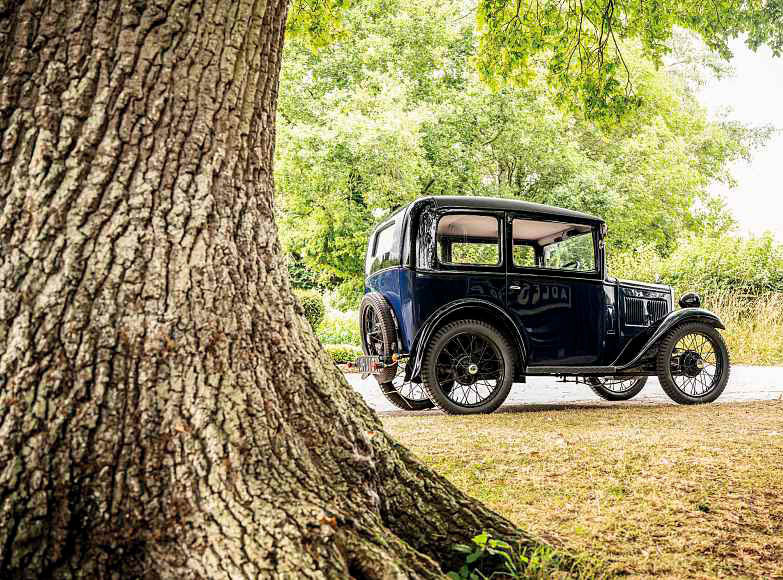
If Tony couldn’t be present, then at least his car could be. I’d been a friend and colleague for over 30 years and felt that driving his beloved Seven to the event would be some kind of tribute, as well as, literally, an emotional journey for me. To my eternal gratitude, his widow Charis liked the idea, too, and a plan was hatched. I’d collect the Seven on my car trailer, take it over to my place in Oxfordshire and then drive it the 30 miles or so to the rally.
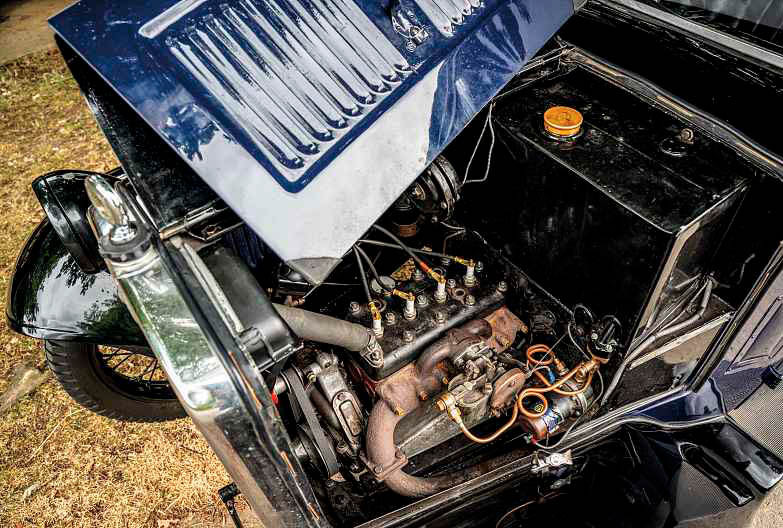
I’ve warned photographer Barry Hayden that a Seven was not designed to carry the modern photographer’s typical kit of portable lights, massive tripod and bulging bag of lenses. This would have to be a guerilla job and so, early one Saturday morning, Barry stuffs a carry-on bag behind the Seven’s seats, while we attempt to stuff ourselves in front of them. Tony was famously lanky – six-foot five and slim as a racing snake – so he had the driver’s seat cushion adapted to form a steeply raked wedge, which raised his knees high enough to drive. While not quite so tall, I’m also over sixfoot and I fit quite well, although dragging my feet past the driver’s door is still an effort. Tony was clearly more flexible.
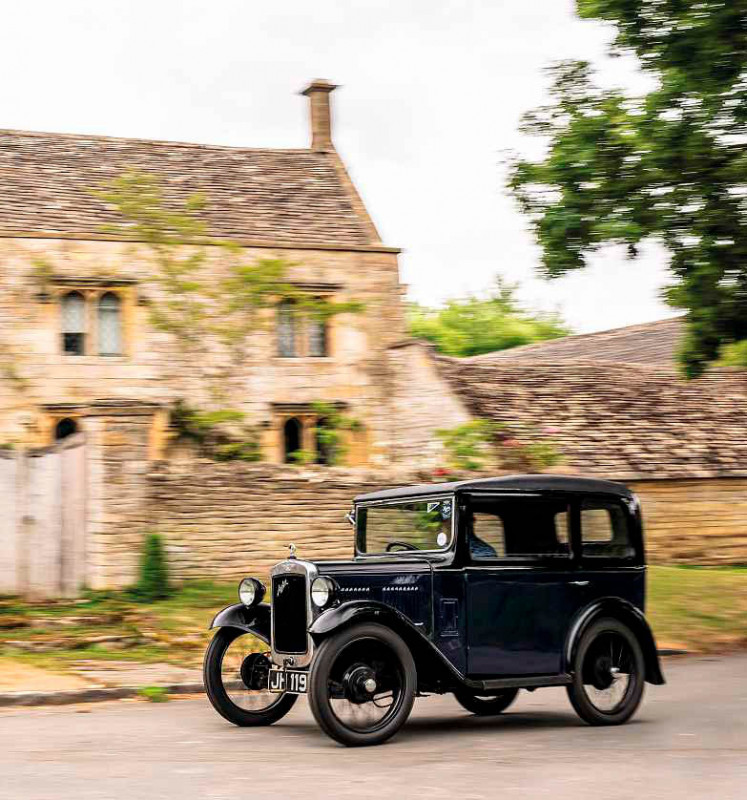
For a cheap family car, the Seven’s dash has more switches and dials than you could shake a stick at – and a starter motor that trespasses into the passenger footwell. The pedals are of the organ-stop variety and, anticipating the Seven’s notoriously on/off button of a clutch pedal, I’ve chosen some faux-racing boots. I’m cursed with great clod-hopping feet, and you know what they say about men with big feet… Yes, they have big shoes.
First things first. Check that the ignition advance/retard lever, pointing up from the steering wheel hub, is moved fully to the left for full retard (Tony was very particular about the correct use of advance/retard) and that the hand throttle lever, which points down, is also positioned left but not all the way. Ignition switch to ‘on’ – there are actually two ‘on’ positions, one for ‘Summer charging’ and one for ‘Winter’, because the Seven was made in the days before control boxes for dynamos – then pull the choke out and press the starter button (mounted alongside the transmission tunnel) and the Seven’s tiny engine fires straight away.
It really does sound and feel like a sewing machine, and a dip on the throttle is reminiscent of running up some curtains on an old Singer. Fortunately, the route between my house and the Seven rally can be strung together from picture-perfect country lanes and B-roads, passing through the tiny hamlet of Adlestrop, made famous by Edward Thomas’s poem (‘Yes, I remember Adlestrop…’). These are very much Seven kind of roads, and even on a summer Saturday we see hardly another car as we bumble past fields ripening with grain and along sun-dappled avenues of trees.
That’s just as well, since the Seven’s engine was rebuilt only 35 miles ago and I’m under strict instructions to run it in gently. Easier said than done, thanks to a massive gap between second and third gear ratios in the three-speed ’box: on uphill grades, you have to make a tough choice between revving it hard in second or labouring in third. When Tony became too ill to carry on working on the car, his local club, the Cambridge Austin Seven and Vintage Car Club, rallied round and its members put the dismantled engine together again. Most touchingly, the CAS&VCC chaps refused to take any money for their labours.
With a few miles under our belt, the shorttravel clutch – it seems to have literally a half-inch of movement – now holds no fears, although hill starts can sort out the men from the boys in terms of clutch control. Still, at least I never have to ask Barry to get out and walk: a 1932 Light Car road test of a Seven over Dartmoor recorded that ‘only on some of the very much steeper acclivities in the heart of the moor was it necessary to shed the passenger’.
On a beautiful day like this, with no time pressures, it’s a pleasure to travel by Seven. The hulking monstrosity of an oncoming modern car holds no fears on even the narrowest of lanes, since the Seven is so tiny that there always seeems to be room to squeeze into the hedge, and its supple suspension copes well with countryside tarmac. You can see why they make good trials cars. There’s a fair bit of body sway as you wind up to a giddy 35mph and the car seems to want to steer from its ‘hips’, although the front end is satisfyingly pointy. Brakes? Well, let’s just say they are adequate. Stopping for a T-junction at the bottom of a steep hill causes momentary anxiety but, at the time, I hadn’t yet read Motor’s 1931 report that ‘to get reasonably short pulling-up distances, we found it necessary to apply the foot and hand brakes simultaneously’.
Nevertheless, we survive. Rolling into the rally location, the Fire Service College just outside Moreton-in-Marsh, we’re amazed to see hundreds and hundreds of Sevens parked everywhere we look. The College is a big site – it used to be an RAF airfield, which has since mellowed thanks to tree growth (rather like Bicester Heritage) – but the Sevens are pretty much filling it. Every age, every type, every condition from barn-find to concours: they’re all here. The organisers had registered more than 1000 Sevens to attend, and it looks as though most of them have made it.
We’re ushered to an age-appropriate spot – the car’s age, not ours – among a host of other 1932 models, and unfurl our legs for a stroll around. It’s quickly apparent that the Austin Seven Clubs’ Association has done an incredible job. It’s not just the cars: there are trade stands, autojumble stands, activities for children, and a superb ‘pop-up’ Seven exhibition in one of the college buildings. Occupying several rooms, it tells the Seven story, from conception by Herbert Austin and the 18-year-old Stanley Edge in September 1921 to the end of production in July 1939, and it’s packed with memorabilia. Fittingly, it will transfer over to the British Motor Museum at Gaydon after the rally, where it can be seen until next Summer. It’s well worth a look.
But, of course, the cars are what it’s mainly about. More than 300 works and coachbuilt versions of the 300,000 Sevens built have been recorded and it seems as though representatives of all of them are here. Besides every variation of saloon, tourer, sports car and racer, there are line-ups of signwritten delivery vans and Seven-based Specials. Among the latter, my favourite is a beautifully put-together Ashley 750 sports car. The finish of its swoopy glassfibre body is outstanding and it illustrates what so many aspiring owners hoped to achieve with these kits, but rarely managed.
Another car that catches the eye is John Day’s RAF radio car. ‘It was built when the RAF were experimenting with radio transmission, using Morse code, and is one of just three known survivors,’ John tells me. ‘It’s a fun car to own because I can take it to military shows as well as classic car events.’
It’s good to see that Seven owners are far from all being the pipe-and-slippers brigade, too. Louis Parkin, aged 23, and his girlfriend Becky have brought along his 1927 Box Saloon, bought with a legacy from his late godfather. ‘He left me money for a round-the-world plane ticket but dad persuaded me that I’d be better investing it in a Seven! We bought this car on eBay and I’ve since found out that it was used in the original 1950s TV series The Larkins. I also own a Seven Ulster rep, which I built-up during lockdown. I’ve just raced it at VSCC Silverstone and we’re about to go on holiday to Normandy in it with other VSCC youngsters.’
Seven people are such a friendly bunch that it would be very easy to spend all day chatting, and maybe sinking the odd pint or two – Tony Dron was very much a fan of proper ale – but we are supposed to be working for Octane.
Sadly, therefore, we have to miss the Spitfire flypast in the afternoon, and instead head back into the Cotswolds lanes for a photo session. Other than being perhaps rather tidier than they were in the 1920s, these byways haven’t changed a lot in the last century, and driving a Seven makes you realise just how relevant such a car can still be for rural transport. Tony liked nothing better than driving this Seven to his favourite pub – a tradition that his widow Charis has just started to revive.
There’s a pleasing circularity to the fact that Tony began his motoring life with Austin Sevens, and finished it with them, too. But the coincidences don’t end there. A few days after the rally, Charis emails to say she’s found the receipt Tony was given when he bought their car. It’s dated 16 November 2010. Tony passed away on 16 November 2021.
Top and right Good ground-clearance means that Sevens are still hugely popular for vintage trialling; Octane’s 6ft 1in dep ed easily fits compact cabin – and Tony Dron had no trouble at 6ft 5in.
‘STOPPING FOR A T-JUNCTION AT THE BOTTOM OF A STEEP HILL CAUSES MOMENTARY ANXIETY’
Facing page, clockwise, from top left Louis Parkin and girlfriend Becky with Louis’ 1927 Box saloon; superbly finished Seven-based Ashley 750 Special; tricoleur rad on visiting Continental two-seater; Sevens as far as the eye can see; John Day in his RAF radio car; Seven spares still plentiful; South African Seven racer ‘Duck’ one of many rarities on display.
Facing page and below Tiny dimensions, supple suspension and 40+mpg fuel economy mean a Seven is still surprisingly relevant for rural driving on minor roads; interior is well-equipped for a cheap car of its era, but notoriously ‘on-off’ clutch and big gap between second and third gears will challenge a novice.
TECHNICAL DATA 1932 Austin Seven
- Engine 747cc sidevalve four-cylinder, Zenith carburettor
- Max Power 10.5bhp @ 2400rpm
- Transmission Three-speed manual, rear-wheel drive
- Steering Worm and wheel
- Suspension Front: beam axle, transverse leaf spring located by radius rods, lever-arm dampers. Rear: live axle, quarter-elliptic leaf springs, lever-arm dampers
- Brakes Mechanically operated drums
- Weight c500kg
- Top speed c50mph
- 0-40mph c37sec


